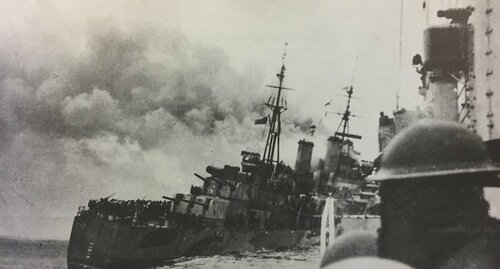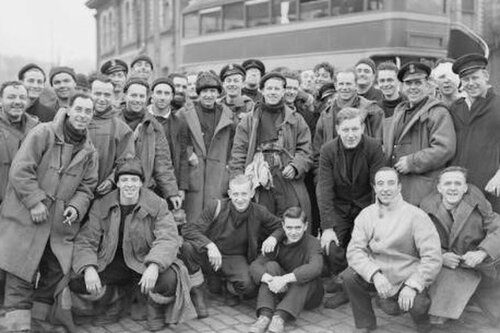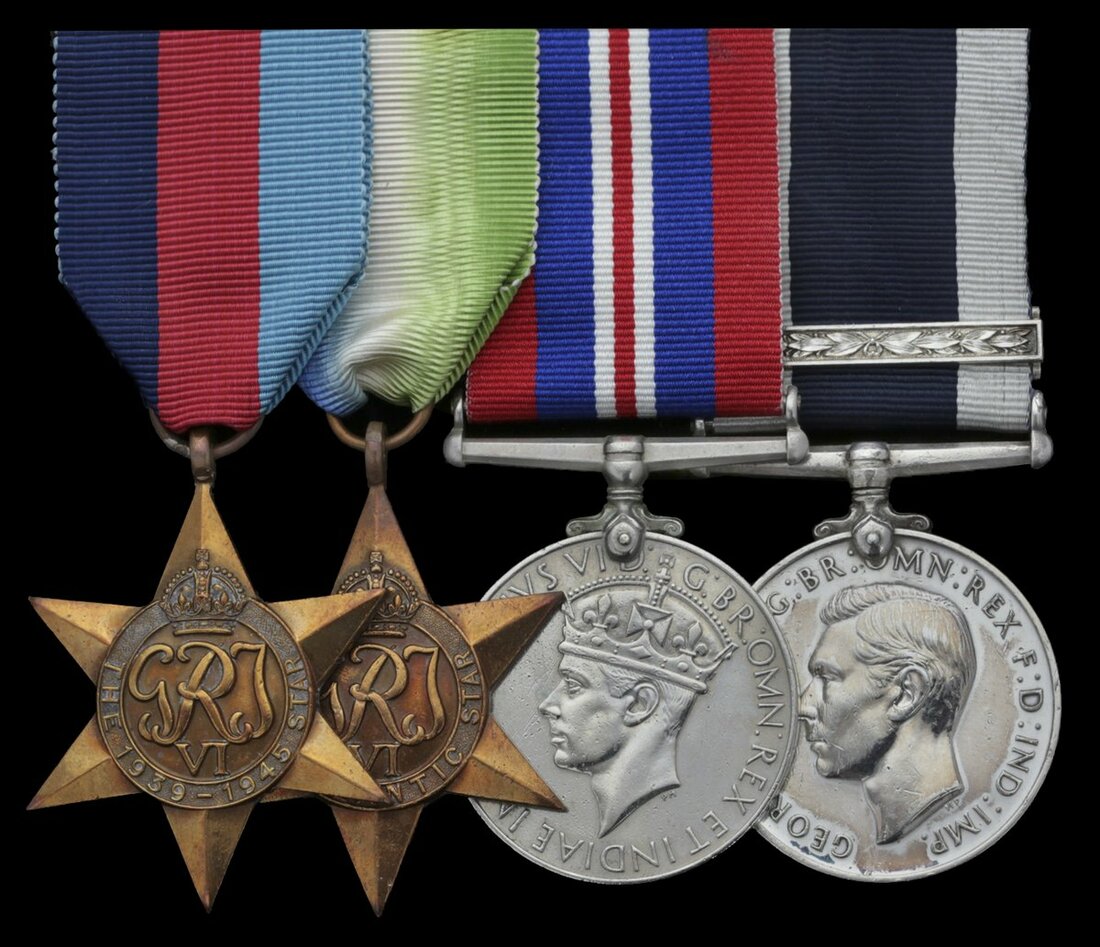Auction: 22001 - Orders, Decorations and Medals
Lot: 283
'It was at this moment that one of the remaining torpedo bombers chose to come in on the port quarter, in a determined effort to apply the coup de grace. High up on the 4-inch gun-deck commissioned gunner Dicky Bunt and gunner Charles Norsworthy were manning the guns to the last to cover the remaining survivors while they climbed aboard the destroyer.
Dicky Bunt, running between the port and starboard sides of the gun deck, was the first to spot the oncoming plane. With a shout of "Nosser, there's one bastard coming in over there," they jumped on to the port gun mounting and watched the aircraft through binoculars and telescopic sights. The plane, approaching fast, was only about twenty feet above the sea and a mile away when first spotted. All the electrical circuits used to train and elevate the gun had been destroyed so the two men were reduced to the primitive method of controlling the mounting by hand. With both barrels loaded they waited. With the cruiser listing to starboard they had an additional difficulty when they tried to depress the sights sufficiently to pick up the target. Norsworthy applied his eye to the telescope and directed the gun as best he could. Dicky Bunt, peering through the binoculars, shouted, "train left - train left stop up a bit - train right," and so on. Changing to look through the open cartwheel sight Norsworthy lowered the guns a little, to give him a target sighting between the bottom of the plane and the sea, and then fired both barrels.
It was a masterful effort for both shells burst about three feet under the plane's port wing, lifting it with such a jerk that it almost capsized. A great cheer went up from the men who watched. The enemy's torpedo dropped off at a crazy angle while smoke and flame poured out of the fuselage. Turning sharply away, the Heinkel slowly lost height and disappeared into the sea. These were the last shells to be fired from Trinidad … '
One of many compelling accounts of H.M.S. Trinidad's final action to be found on the 'World War.com' website under 'WW2 Cruisers'.
A Second World War campaign group of four awarded to Acting Leading Seaman R. C. Thompson, Royal Navy, who survived the trials and tribulations of the cruiser H.M.S. Trinidad on the Artic run in March-May 1942
In acting in the defence of PQ-13, Trinidad engaged and damaged a German Narvik-class destroyer but then one of her torpedoes malfunctioned and hit her as she turned on a new zig-zag course, killing 32 of her ship's company
Emergency repairs having been undertaken in the Kola inlet, she headed for home at a reduced speed of 20 knots and was caught by swarms of Ju. 88's and Heinkels on 14 May 1942: having endured relentless attack and several direct hits, she was set ablaze with further heavy loss of life and the decision was taken to abandon ship
For a compelling account of Trinidad's ordeal, including eye-witness testimony, see:
https://www.world-war.co.uk/trinidad_loss.php
1939-45 Star; Atlantic Star; War Medal 1939-45; Royal Navy L.S. & G.C., G.VI.R., 1st issue (J. 125449 R. C. Thompson, A./L.S., H.M.S. Watchman), mounted as worn, minor contact wear, good very fine (4)
Robert Craig Thompson was born in Ballymena, Co. Antrim on 9 May 1910 and entered the Royal Navy as a Boy 2nd Class in November 1925.
By the outbreak of hostilities in September 1939, he was serving as a Leading Seaman in the cruiser H.M.S. Newcastle, and he remained similarly employed until October 1940.
Loss of H.M.S. Trinidad
Having then been employed ashore in the interim, he joined another cruiser, the Trinidad, in October 1941 and he was likewise employed at the time of her loss on the Arctic run in May 1942.
While acting as an escort to the Arctic convoy PQ-13 in March 1942, Trinidad fought an engagement with German Narvik-class destroyers. She hit and damaged the Z 26 and then launched a torpedo attack but one of her torpedoes malfunctioned, limping across the water at a much-reduced speed and, as Trinidad turned on another evasive zig-zag movement, it struck her with devastating consequences: in addition to many wounded, 32 of her ship's company were killed.
Towed clear of the action, Trinidad made Murmansk under her own steam, and underwent emergency repairs in the Kola inlet. She then set course for home on 13 May 1942, with a destroyer escort, but her reduced speed of 20 knots made her an easy target for the Luftwaffe. The following day she was subjected to relentless attack by swarms of Ju. 88s and torpedo equipped Heinkels and suffered untold damage and a further loss of 63 men, including four embarked Czech airmen and 20 survivors from her consort Edinburgh.
The decision was taken to scuttle her and once her survivors had been transferred - including Leading Seaman Thompson - she was finished off by torpedoes from the destroyer Matchless.
One of Thompson's fellow survivors from the Trinidad was the composer George Lloyd, a Royal Marines bandsman who had written the ship's official march.
The march was performed at The Last Night of the Proms on 7 September 2013, in the presence of Trinidad's last surviving crew. For further details, see:
https://www.bbc.co.uk/news/uk-wales-south-west-wales-23993233
Subsequent wartime career
Thompson's final wartime employment was in the destroyer H.M.S. Watchman from July 1942 to July 1945, in which period he served on the Atlantic run and was awarded his L.S. & G.C. Medal.
A month after he joined Watchman, a new Gunnery Officer came aboard, one Lieutenant Ludovic Kennedy, afterwards the famous broadcaster and author. The following extracts have been taken from his autobiography, On My Way to the Club:
The ship:
'She was a very ancient ship laid down in the First World War and recently pulled out of mothballs and given an extra fuel tank to help shepherd hard-pressed convoys across the Atlantic. We were to be part of an escort group consisting of another destroyer, ourselves, and six corvettes. Our armament consisted of a single 4-inch gun below the bridge for loosing off at U-boats (and Tirpitz too if she happened to pass our way), a couple of anti-aircraft guns and lots of depth charges … '
Captain and crew:
'Nor were things helped by the ship's low morale, especially in the wardroom. The captain, a retired Lieutenant-Commander, was a dear man, large, bald, unflappable, as slow-moving as his ship … He had a nice sense of humour, too. "I see you're wearing your lifebelt round your tummy," I heard him say to a look-out. "In the water you'll float bottom up. What makes you think you can breathe through your arse?" But at sea he remained in his tiny cabin below the bridge and, except when on watch, we never saw him. Our bete noire was the First Lieutenant, disliked equally by wardroom and lower deck. A peacetime R.N.V.R. officer, he was petty-minded and obsessed with detail as his background of a solicitor's office in a small town in Wales might have led one to expect, and we all resented the high-handed, often petulant way he addressed the crew.'
Enemy intelligence gathering:
'The escort group to which Watchman belonged was based at Londonderry, poised between Ulster and the neutral Irish Republic. Once a month or so the group would slip down the River Foyle, watched from the left bank by representatives of the German ambassador in Dublin who lost no time in informing Berlin of our departure … '
Against the odds:
'When we sailed with our first convoy the Battle of the Atlantic was at its height. In June U-boats had sunk 144 ships, in July 96, in August 108. Now, with no less than forty-two U-boats on station between Greenland and the Azores, Admiral Donitz was about to launch a new offensive. We guessed it would only be a matter of days before we were in action … '
As it transpired, during Kennedy's time aboard Watchman, she completed several convoys without mishap, though other convoys - ahead and astern of her own - were mauled, some savagely. On one occasion Watchman did engage a U-boat with her 4.5-inch gun, scoring a near miss before it dived.
Postscript
Thompson served in the Fleet Air Arm after the war and was finally pensioned ashore as a Petty Officer (A.) in December 1960.
Subject to 20% VAT on Buyer’s Premium. For more information please view Terms and Conditions for Buyers.
Sold for
£420
Starting price
£130









